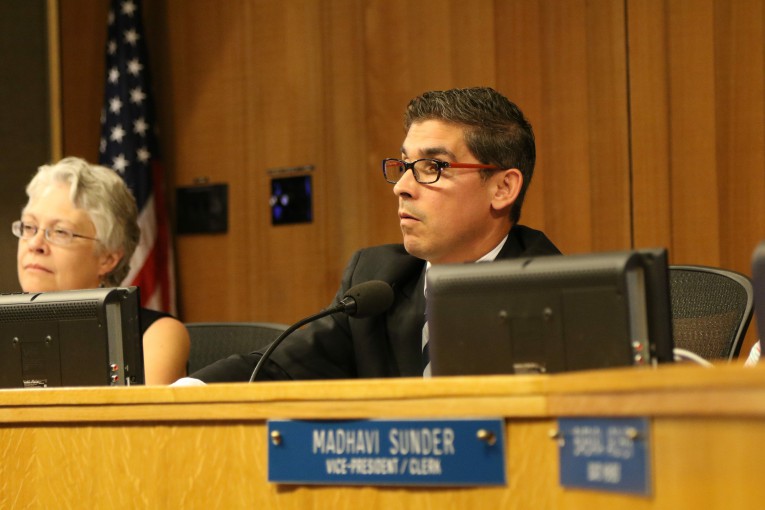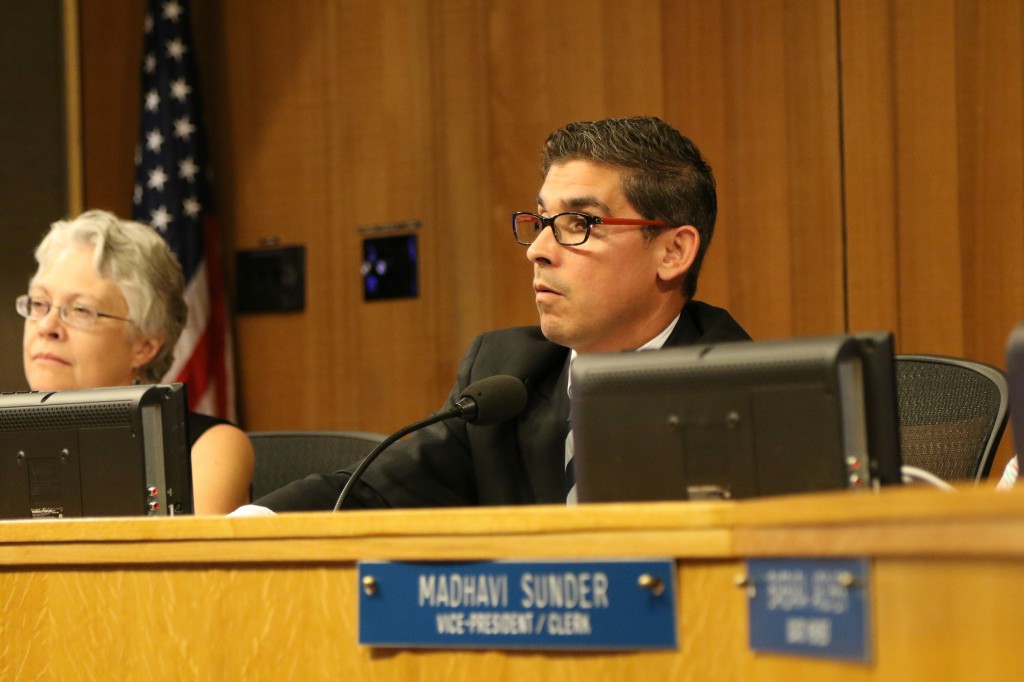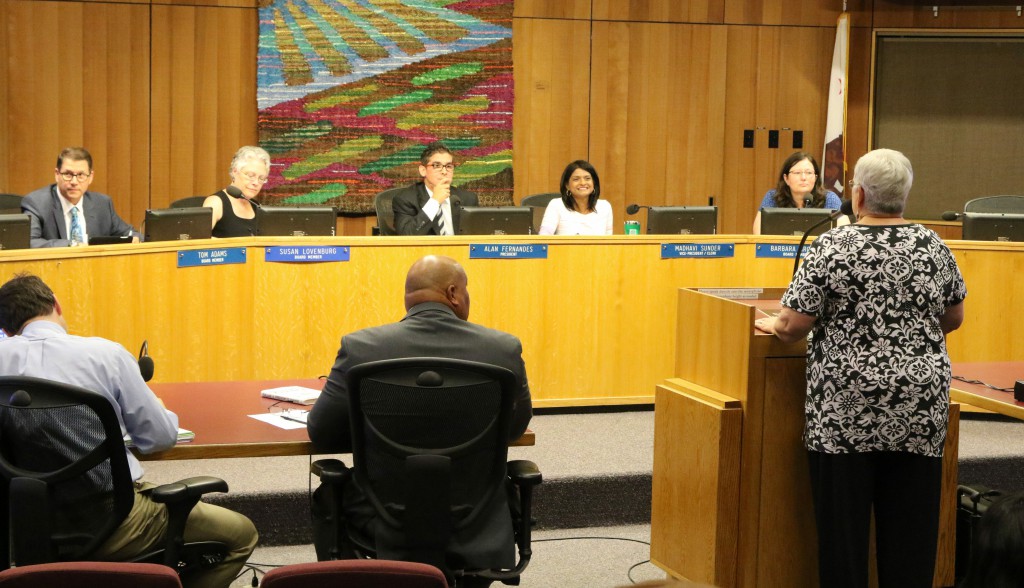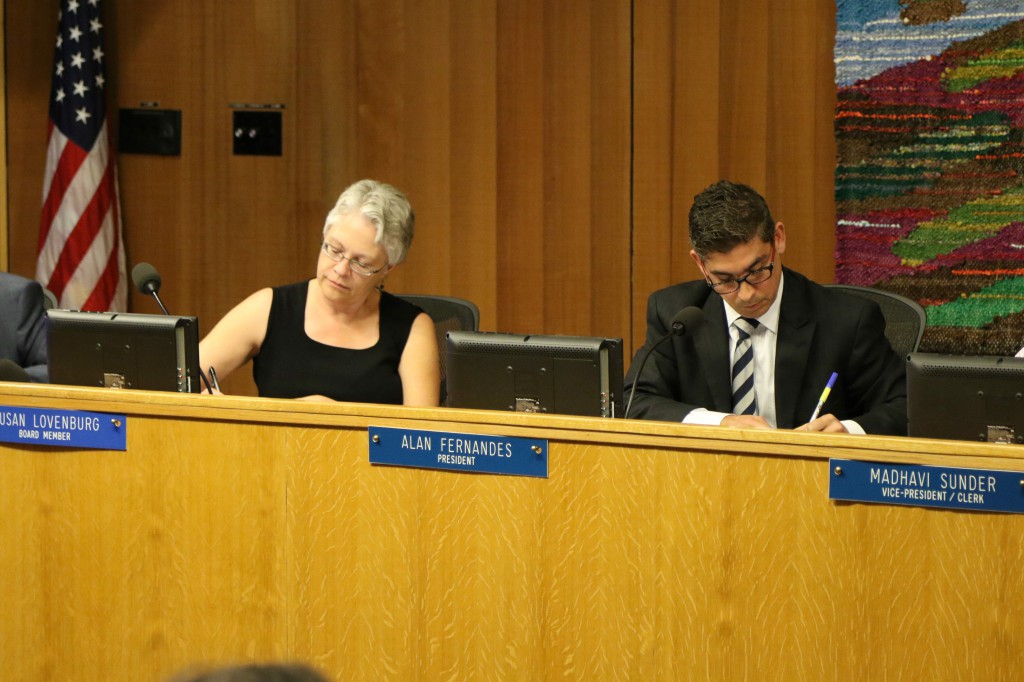

Part One – Board Comments
Civic engagement does not end when the school year ends, and, to prove it, the DJUSD Board of Education held a special meeting allowing parents and community members to speak out on recent and proposed changes to the AIM program.
Forty-five people in all spoke – many passionately and many making strong and eloquent points on both sides of what might be described as the divide. There was a slight advantage in the audience and among the speakers to the pro-AIM side of the issue – but it was slight.
By our count, 24 of the 45 speakers were in favor of GATE. Almost the entire left side of the chamber seemed filled with GATE supporters, while 75 to 80 percent of the right side (which was maybe at 60 percent capacity) was pro-change.
Following the nearly two hours of public comment, Board Vice President Madhavi Sunder asked to be able to make a comment. She also urged her colleagues to speak, and they obliged with Barbara Archer also reading from a prepared remark.
Ms. Sunder said, “I’ve had many many conversations with individuals about the AIM program. One comment kept coming back to me from one conversation — I really appreciated this quote from our Superintendent, Winfred Roberson. He said, ‘We move at the speed of trust.’”
Ms. Sunder stated, “I’ve been thinking a lot about his words. I’m concerned because I think we were moving as a Board quite a bit faster than the public trusted us to be going. I think we need to slow down a bit.”

“We don’t need to reinvent the wheel,” she said. “We have a public process that works – it involves stakeholders and it is the building material for trust. If you try to circumvent the public process, you sow the seeds of distrust. The process creates important tangible benefits – first, you get a better product, and second, it engenders trust. To circumvent this public process would be a mistake.”
Susan Lovenburg agreed, “I think it’s important for public bodies to be transparent and to be open and receptive to take open minds to every policy decisions.” She noted hours-long discussions in March and June. “That motion came at a late hour because we had spent more than three hours discussing it at that point and receiving public input,” she said.
Barbara Archer responded in contrast to Madhavi Sunder’s claim that the board hasn’t been heard from, and that they talked about this issue for four hours in March and another four hours on June 4. “I asked many many questions that night, so I think we had a good dialogue about it,” she said.
Ms. Archer noted that GATE reform has been a discussion for several decades. “The debate over how we should serve our students in this program has been going on for nearly 20 years now,” she said.
Ms. Archer said she’s been urging for reform to the GATE/AIM program for seven years. “So when folks urge us to take a step back and stop rushing this – how many decades do you want to review it?” She added, “Even those in this room, who support the self-contained only model, agree that the program identifies too many students.”

Barbara Archer addressed the late night vote that keeps coming up. “When people say that it implies this was slipped in when no one would notice. People tend to leave out that this was a decision after again four hours of conversation on June 4 and four hours of conversation on March 19.”
“The room was full for both meetings,” she continued. The meetings are the only places, she said, where they can discuss these matters. “Therefore new direction and decisions come out of these meetings all the time. You may not agree with the direction or the decision but that is the process.”
Barbara Archer said, “This is a complex issue and change is hard. But it is our district’s job to use our resources and our pedagogical tools to teach all our students in the best way possible. Many districts have moved from self-contained models to differentiation. Many districts have moved to models where GATE classes are smaller.”
She added, “Our staff is using the summer to look at best practices and will bring back a proposal in the fall.”
Tom Adams reiterated, “The charge that keeps coming up is that the program is being eliminated. There was no vote on eliminating the program. The only thing that was eliminated was private testing.”
Board President Alan Fernandes said, “I have an open mind (as to where things stand), and I have taken notes and thoughtfully listened to everyone tonight. I heard great suggestions from both viewpoints.”
He announced a tentative date of September 19 for further discussion.
—David M. Greenwald reporting

The whole reason this meeting was even necessary was because the Board tried to sneak in a major change without a (legally required) public process. The length of their discussion at that time is irrelevant. The Board members should know better than to play fast and loose with public process #NancyPeterson
It sounds like the Board members who are telling us they discussed this for hours at two prior meetings are telling us they’ve already made up their minds, their ears are not open to public comment and they’re just going through the motions to appear o have taken input from the public. Ms. Sunder was right. I watched the tapes of those two meetings and the discussions were on the studies, not on the motion they passed. She also asked the other trustees in June what their vision of AIM would be under the motion Lovenburg made. They specifically refused to answer. They refused again last night. Why do they feel no accountability to the public to present and explain their views and votes???
I can’t believe they’re going down this path after all the backlash that the board received after the Peterson debacle. You would’ve thought that they would’ve done everything by the book with all their t’s crossed and i’s dotted after that incident.
Archer stated,
I do not recall her campaign material calling for the reform of the GATE/AIM program. Did she lie about her true intentions during the campaign. Can she be trusted in the future.
You are right, zaqzaq. This is what Archer told the Vanguard — https://davisvanguard.org/2014/10/school-board-candidate-question-4-gate-aim/ . — Anyone know what Tom Adams had to say on this? He did not respond at all to the Vanguard.
Barbara Archer: I have not been involved in the GATE/AIM district advisory committee meetings. When I was a member of the Willett Site Council, we had a rep who reported back to the group from that meeting, and we discussed school climate issues related to the program.
Being part of a campus with a GATE/AIM track for 10 years allowed me to hear about the many perspectives on GATE/AIM from parents, teachers and students. I have also talked with many community members during the campaign – people with kids in the program, people with kids not in the program, people whose kids were in the program 20 years ago and middle-aged Davisites who were in the precursor to GATE/AIM – Mentally Gifted Minors.
Some parents believe that self-contained classes of AIM-identified students are the best way to educate their students. Some parents who have kids in the program are not wedded to the idea of the self-contained model. Some parents have AIM-identified kids and choose to do the neighborhood program because they do not agree with the self-contained model. Some parents believe that we must put equal resources toward all needs – GATE/AIM, high achieving, learning disabled, and students who struggle with academics to name a few groups. Some parents believe that the self-contained model is out-moded, and we should look into more current models for serving AIM-identified students.
What I believe is that that we owe it to our students to learn what other districts are doing to serve students working above grade level including examining current best practices and the advantages or disadvantages offered by flexible ability groupings. We must look at educational research and district data and consult with education experts to see if we are serving our students the best way we can. This has been a difficult community conversation, and my hope is that we can bring all parties to the table to discuss the future program direction.
Regarding balancing needs of all our students, I think it would best serve our students to make sure that all children have an enriching education regardless of ability level.
Question: Is this current discussion really about the elementary AIM program only? Is the 7-10 grade program of any interest to anybody?
“We have a public process that works –”
Define “works”
“If you try to circumvent the public process, you sow the seeds of distrust.”
Eventually you will need to make a decision, and those against your decision start against your decisions and will remain against your decision.
“The process creates important tangible benefits – first, you get a better product”
Not necessarily. If you are talking about the discovery and analysis phase before the decision, then yes. If you are talking about getting a lot of people to voice their opinion after you have already made up your mind what you believe is the right course of action, then no.
“, and second, it engenders trust.”
Trust in the process… which I agree is important only to prevent those against your decision to use as a criticism to political retribution for your decision.
“To circumvent this public process would be a mistake.”
It depends. Do you care about doing the right thing and making a timely decision once you know what your decision will be? Or, do you care more about politics of the thing?
These are all fantastic arguments against the Brown Act, public engagement, and (pause for dramatic effect) democracy itself. Who cares what people think “after you have made up your mind”, am I right? That makes it much easier make “timely decisions”.
All hyperbole aside, I think that is exactly the point. There was no “discovery and analysis phase”, the Board just jumped straight into “mind made up”.
“No such thing as a crisis….its just the end of an illusion”
1/3 of all Davis Kids qualify for GATE, so what we have is a tracking program for elementary school kids. This is not consistent with the GATE charter or much research that justified it initiation.
1/4 of those who qualified for GATE did not find slots, yet no support for differentiate instruction for these kids in the normal classroom.
Testing program to get in seems to discriminate based on a court finding….
You can “buy” your way in via private testing
The GATE program and its advocates have not addresses these issues.
Last night I heard status-quote advocates express “shock” and “Surprise” at the “rapid change” 4 of the board members are calling for to address them. .
But advocates for change to GATE say they calling for reform for years.
That status quo advocate now claim to be “surprised” reinforces an impression they have not taken criticism of old program to heart and tried to evolve it address these community concerns–concerns that elected 4 of 5 board members.
Four members on the board is clearly want to address these issues–but the way forward is not clear and I don’t hear any of them being positional. They asked District staff for idea. And given the time frame they have laid out, we have 14 month of community discussion time to figure it out. We can be thoughtful.
It is time for people to suggest solution instead of harping on process. With a 4:1 board majority, even if the motion in June–which was only to negate private testing — was undone as ( the defined legal remedy under the brown act), a new vote in Sept would not change anything.
For those who want to maintain the status quo, It would be a major contribution to provide a justification for defacto tracking and how the issues and inequities in it can be addressed–or why they should be ignored as insignificant.
I know the Vanguard would welcome printing a justification for TRACKING… including how kids would be selected, or other ideas how to evolve a self contained program or some hybrid.
We have 14 months to figure this out….its time to be thoughtful, not vindictive.
I think this is a key issue.
Not any more, apparently.
Depends on what you mean by reform. Some are calling for the abandonment of self-contained GATE. Others just want to fine-tune the testing and expand differentiated instruction.
Ok.
Eliminate private testing.
Develop and fund some pilot programs for differentiated instruction. Assess those programs in 2 – 3 years.
Make a firm verbal commitment to continuing self-contained GATE for those who need it.
Allow some referrals from counselors and teachers, irrespective of the subjectivity that involves, for students who seem to need self-contained GATE in spite of lower test scores.
Seek professional input as to the most effective testing (good luck).
Do outreach to explain the program(s) to parents of under-represented groups.
Assess the level of commitment and the efficacy of the program in grades 7 – 12, especially 7 and 8.
Then there’s the way they treated the AIM coordinator. It looks like they have listed her position as in-district only (after taking the listing that was up down after they fired her), but waited to list it until just AFTER her position ended so that she is no longer a district employee and is therefore ineligible to even apply for the job. I’m sure that’s completely coincidental, right?!?
Don, this sounds good, but there is an issue of timing.
We eliminate private testing. With over a 3rd of the students being identified this way, what do we have to offer parents who think their children are gifted in the 2-3 years that pilots are being run? Would the parents be willing to have their child be part of a pilot?
Develop and fund some pilot programs for differentiated instruction. Do you believe that differentiated instruction is not already happening in our schools? What do you think is already happening with the GATE identified students who did not win a seat in the lottery? What do you think was happening when GATE was only 2-3 strands and yet we had high test scores and highly successful graduates?
Make a firm verbal commitment to continuing self-contained GATE for those who need it. I believe that this is in writing – see the Superintendent’s letter to the community.
Seek professional input as to the most effective testing. I believe that this is what the Board directed staff to do. However, there are people who seem to think that Deanne Quinn is the only person qualified to determine this.
Do outreach to explain program(s) to parents of under-represented groups. OK, but I think offering differentiated instruction at the school near their home, where friends in their neighborhoods and siblings attend, would work better than recruiting them for a self-contained program elsewhere. Frankly, I don’t understand why this isn’t already being done other than there being a desperate need to diversify the self-contained program. If the parents decline, what is happening with these children now?
Assess the level of commitment and the efficacy of the program in grades 7-12, especially 7 and 8. I would add to this to find out what happened to advanced English, etc. for students who did not do their elementary education in the GATE program. Why have all the honors courses been gobbled up by GATE?
I am still intrigued by San Diego where they cluster GATE identified students and only have a small percentage of students in self-contained classrooms.
Obviously not. Otherwise, why would the board have given staff the direction they did at the June meeting? Why would parents be asking for differentiated instruction (see wdf’s comments). What is already happening? Those students are not being served well. My solution to that would be to consider expanding the GATE program. But clearly that is not the direction this board is going to go. So, I agree: San Diego has a good model to consider, but it would take some time to get there.
It isn’t the Superintendent that we need to hear it from. The Superintendent didn’t fire the coordinator or make the statements and decisions that have brought this to a head. The commitment needs to come from the board majority, and it needs to be credible.
Don, the Board direction was not to start offering differentiated instruction, but to focus its assessments procedures to identify students who would not be successful in classrooms that offered differentiated instruction. Last night several teachers from non-GATE classrooms assured the Board and the public that they are already delivering differentiated instruction in their classes and attended conferences and educational workshops, including ones in GATE education, to help them in providing this. With the implementation of Common Core, this will become even more important.
Well, then, everything’s fine! Nothing to be concerned about.
Per the Vanguard report, the direction to staff with regard to differentiated instruction was for “developing a plan for the district which fully implements differentiated instructional practices in classrooms….”
Wouldn’t be necessary to develop a plan if they were already doing it, eh?
I don’t think anyone said Deanne Quinn was the only person qualified to do that. But she is (was) the most qualified in our district. I am curious to see how qualified a person they will find now. When they fire the person who has proven her abilities and earned the trust of those families with no explanation, it destroys the AIM community’s trust in the Board. I have never heard that she has not acted as the Board has directed. To me it appears she was fired because the majority of the Board want the program gone ( decimated) and they view the fact that she is knowledgeable and competent and has the trust of AIM families as a threat to that plan. The Board should have directed her to modify the program per their direction, and she could have helped smooth the way between the Board and AIM families and teachers in the transition.
I guess it’s just too bad for them. My opinion is that they should continue the present GATE/AIM program, try the pilot program of differentiated GATE and see how the parents and students respond. If it’s successful, they can gradually raise the standards for self-contained GATE and reduce the sizes of those classes, assuming they still have enough enrollment to maintain the self-contained programs. In other words, gradually work toward the proportions they have in San Diego. But here is the motion Susan put forward:
If they do nothing other than that, the program will shrink by default.
Don, you are right about the direction given to develop differentiated instruction. “”Further, direct the Superintendent to develop a plan for the district which fully implements differentiated instructional practices in all classrooms.”
Maybe that’s why teachers were coming to the Board meeting giving testimony that they already are providing differentiated instruction in their classrooms. Everybody, including members of the Board, is assuming that it is a one size fits all in the regular classrooms.
If students were clustered in regular classrooms, with no less than 25% GATE identified students in each class (7-8 children minimum), would that make it easier to deliver differentiated instruction, do you think?
I think that would be key; sort of a peer group within a peer group. Seems to be what they’re doing in SDUSD.
Hirsch: 1/4 of those who qualified for GATE did not find slots, yet no support for differentiate instruction for these kids in the normal classroom.
Does that represent students on a wait list? or does that include students whose families opted not to participate in self-contained GATE/AIM?
All these “fixes” assume having 1/3 of student segregated out from Normal students is a fine solution, as they learn 1) Differently…and/or 2) faster. They assume only problem is to identify these students who different this way.
Does anyone have any science that says there are only have two ways to learn….maybe there a multiple ways? maybe we should have three self contained tracks– or 4 or more as indicated by theory of multiple intelligences? Are their only two “learning speed” grouping? Maybe there 3–or 4?
Do all “special” students learn need instruction using “alternate” methods for all subjects? Might some student need alternate methods for some subjects but not others?
Do kids learn faster/differently for all subjects or just some?
On testing, don’t think the answer is simple otherwise the district would have already found the test or method to “objectively” measure if a child is “type A” or “Type B” learning….particularly when parents are not looking for the “best” teaching method of their child, but have a bias for one method or pace of instruction.
Let’s start with what the Science says….then lets figure out the optimal structure of teachers/class rooms and how to differentiate…and how to identify those that fit in the different categories.
And if segregated instruction is the ideal learning model, why not have PE segregated classes also– based on learning style and physical capacity? We now have significant obesity/physical fitness problem in the US and this effects people life span…that is pretty primal (unless you think school is only about training for a job in industry and not training the whole child). If special segregated classes is the best way to learn, why not for PE also?
What does the science say –and how to we apply it consistently to all subjects?
My high school implemented a separated PE system. At the start of the year you could choose team sports or individual sports. Those in individual sports could devise our own schedules, playing handball, tennis, badminton, or doing track and field, weights; we could also sign up for the separate programs of gymnastics or the dance classes that were mostly for the girls. Those in the team sports did the traditional football/baseball/soccer/track/wrestling rotation. The program recognized that there were different exercise styles, and different preferences for athletics. It also got those annoying hippie-types off the team sports, where they were a drag on the performance. Worked well for everyone, actually.